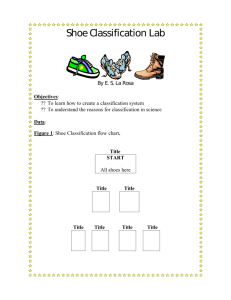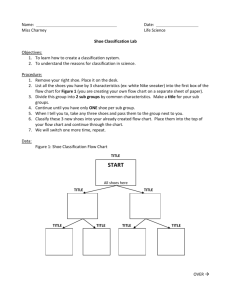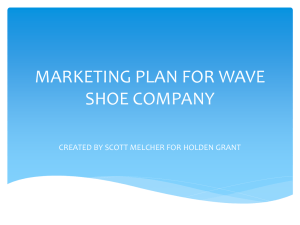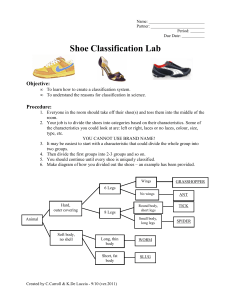Research Paper (SNEAKER INDUSTRY)
advertisement
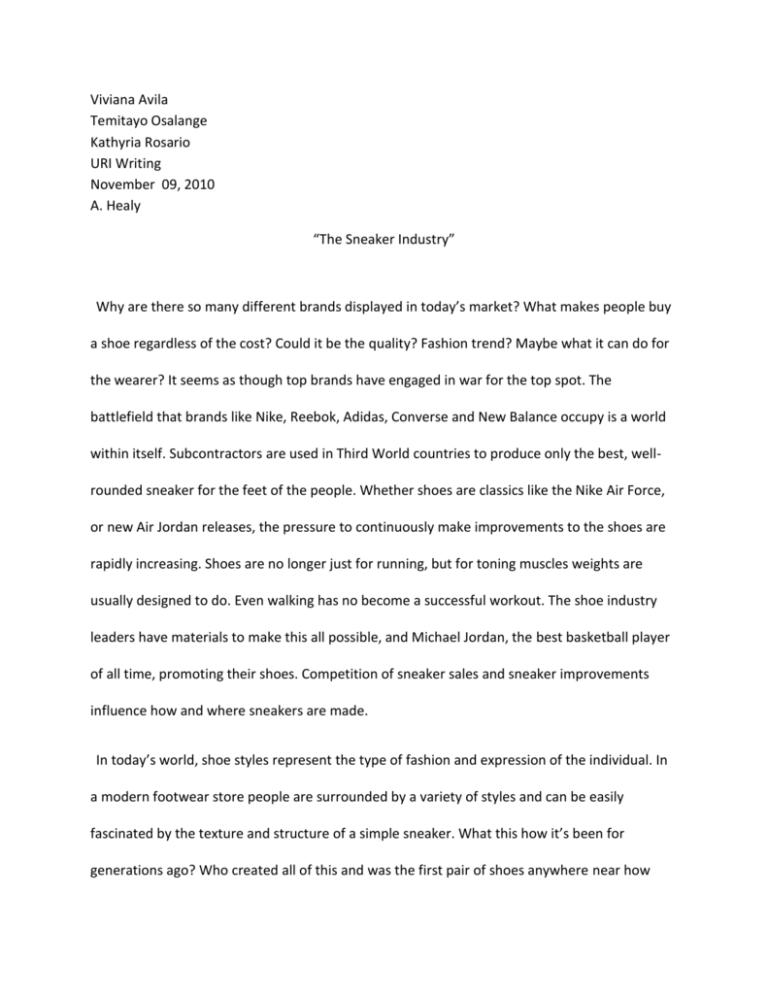
Viviana Avila Temitayo Osalange Kathyria Rosario URI Writing November 09, 2010 A. Healy “The Sneaker Industry” Why are there so many different brands displayed in today’s market? What makes people buy a shoe regardless of the cost? Could it be the quality? Fashion trend? Maybe what it can do for the wearer? It seems as though top brands have engaged in war for the top spot. The battlefield that brands like Nike, Reebok, Adidas, Converse and New Balance occupy is a world within itself. Subcontractors are used in Third World countries to produce only the best, wellrounded sneaker for the feet of the people. Whether shoes are classics like the Nike Air Force, or new Air Jordan releases, the pressure to continuously make improvements to the shoes are rapidly increasing. Shoes are no longer just for running, but for toning muscles weights are usually designed to do. Even walking has no become a successful workout. The shoe industry leaders have materials to make this all possible, and Michael Jordan, the best basketball player of all time, promoting their shoes. Competition of sneaker sales and sneaker improvements influence how and where sneakers are made. In today’s world, shoe styles represent the type of fashion and expression of the individual. In a modern footwear store people are surrounded by a variety of styles and can be easily fascinated by the texture and structure of a simple sneaker. What this how it’s been for generations ago? Who created all of this and was the first pair of shoes anywhere near how they are represented now? The first shoe was created and worn by our early ancestors and the primary purpose was to protect their feet from harm. Such as, rocks, debris on pathways, weather conditions, etc. The Indians of Central and South America created the shoe with a fabric called Cautchouc, what they called “weeping wood” which is rubber. This material was used for sandals which were the first shoes worn by man and invented by the Ancient Egyptians. Then they were left for moccasins and boots in the middle ages. Shoes back then were fastened with buckles instead of shoestrings. Now, the shoes worn have sting and shoe holes. Shoe strings were created in England in 1790. Shoes were being made by hand, it wasn’t until Jan Ernest Matzeliger and Lyman Reed Blake created a procedure by inventing a sewing machine to maintain shoes that last and sold at a reasonable price for the consumers. The first production of shoes was in Lynn, Massachusetts in 1760. The first manufactured shoe was established by a Mayflower pilgrim Thomas Beard. In 1843 Charles Goodyear established the process of vulcanization. Which was just to remove the sulphur from the rubber, heat it, and then it would remain its elasticity. This process made rubber water proof and winter proof. The shoe idea and design can be the hardest part of the process. The question to keep in mind as the creators design the shoe is: “What would sell and what wouldn’t”. An article by Pam Archer, states what to look for in an athletic shoe before purchasing. She states to look for a shoe that is specific to the type of sport. If you’re a runner, get shoes made for runners. If you are attending an intense cardio or dance class, need specific shoes for that. Basketball player? Basketball shoes. She also explains how the consequences of purchasing shoes just for the brand name or style can cause damage to shins, ankles and other orthopedic damages. The production companies then need to look at this and make a shoe that they can sell for a reasonable price and succeed in satisfying the customer. Aside from comfort, the style and popularity of the shoe contribute to what is possible in selling. A website, theshoegame.com, posts an article on how Nike Air Jordans are the “hottest things smoking when it comes to authentic and real deal”. Once they see Michael Jordan on the television screen promoting the shoe, the people want it. The person’s “swagger” is dependent on these shoes. Involved with all these strategies, what’s used in the shoe helps production. The upper part of the shoe is made up of three materials; leather and mesh. The midsole, used to provide protection and cushion, are made of phylon- EVA foam pellets that are compressed, heat expanded, and cooled in mold- PU, most dense and durable and stable, or also known as polyurethane, phylite and EVA (Ethylene- Vinyl Acetate). The outsole is the first stage of cushion and made of leather or rubber. Once all the materials are picked, the production begins. Workers cut out each shoe part and gather parts for each shoe into a bag. The bag of parts is passed to the stitching room where the workers use a sewing machine to assemble the parts. The final assembly is done on a 150 meter long assembly line. On the line, the stitched shoe is glued to the rubber bottom. At the end of the assembly line, workers attach the shoe laces and box up the shoes. The product is transported by the shoes being packed into shoe boxes, gathered into 12 count case boxes. These cases are then loaded into an ocean shipping cargo containers. Metal containers are 40 feet long, 8 feet high and 8 feet wide. The container can hold about 5,500 pais of shoes. The container is trucked by the harbor once it reaches its destination and loaded into container ships. A container ship can carry over 1000 containers that can sail from china to the USA in 10 days and to Europe in 20 days. Once the ship arrives, containers are moved by truck or rail to distribution warehouses. At the warehouses, the containers are emptied and repacked for trucking to the shoe stores. It takes about 18 months until the shoe is in stores. The cost to ship a pair of shoes from China to the USA is about 50 cents a pair. The regular based shoe is not created by Americans. Shoe companies are not familiar with making their own shoes so they manufacture their shoes overseas in Asia for the lowest possible wage. In an article distributed by the Campaign for Labor Rights, Tim Glenn talks about Nike’s cheap labor and its conditions. Most of the shoe workers in Asia are teenagers and unmarried young women from ages 17 to 30. The average worker produces 4.3 pairs of shoes a day and only gets the minimum wage of $2.50 a day in Indonesia. The daily livable wage in Indonesia is between $4.00 to 4.50. Certain conditions in Vietnam are even worse. Workers only make an average of 20 cents per hour, or $1.60 a day, when the cost of eating three simple meals is $2.10 plus other expenses such as shelter. About sixty to seventy percent of Nike's overseas workers rent a room in the Nike dormitories. The rooms are all identical, one-story buildings which face each other in rows. The rooms are three meters by three meters, which are made of concrete walls and floors, where two or three young women live. The workers who rent the dorms have to pay a fee of $6.00 a month Nike spends between $250-$280 million dollars a year on athletic endorsements. Nike admits that the direct labor cost to produce the shoe is about $3.50, which doesn't account for Nike's marketing or distribution costs. So the people would pay more for the shoe then it was to be made. Under these conditions counterfeit sneakers come about. By the mid- 1990s a new brand of factory, specializing in fakes, began copying authentic Nike, Adidas, Puma and Reebok shoes. So far this year the U.S government agencies have seized $40.3 million worth of counterfeit shoes in cargo containers. Sneakers are the most counterfeited product known to the U.S. Forty percent of the total knockoff goods seized by the U.S government agencies last year was sneakers. The companies lose an average of $12 Billion a year due to counterfeiting. Overall, the sneaker continuous battle for the brands to achieve the highest possible profit rate if immense. Each company takes drastic measure to make sure that their shoe sells the most and the highest. They spend millions of dollars a year to get the most popular athlete to promote their shoes and the people become attracted like a magnet. The companies use strategies to help shoes become more convenient. Reebok tone is now designed to tone the muscles, now New Balance has come out with a shoe similar to that. It’s a constant battle, never ending. Shoes are making drastic changes.


